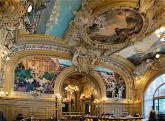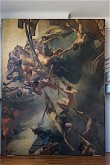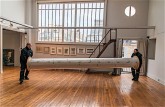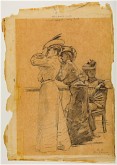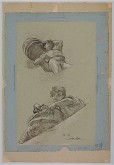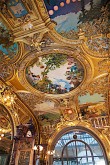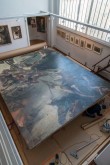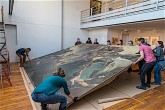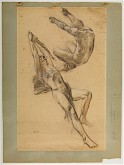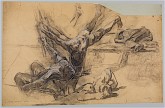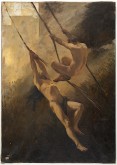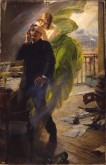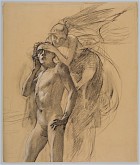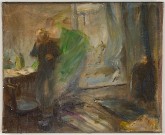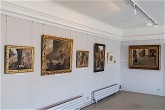The browser will either open the file, download it, or display a dialog.
Albert Maignan Décorateur du Paris Fin-de-Siècle
Fondation Taylor, Paris
March 11–May 7, 2016
and
Les Voix du Tocsin, genèse et résurrection d’un chef-d’oeuvre
Presented in the Atelier of Albert Maignan, Paris
March 11–July 16, 2016
Catalogue:
Albert Maignan, Peintre et décorateur du Paris fin de siècle.
With essays by Alain Gest, Bruno Foucart, François Legrand, Véronique Alemany, Olivia Voisin.
Paris: Editions Norma, 2016.
175 pp; 86 color illustrations; 72 b&w illustrations; bibliography; index.
25€
ISBN 978-2-1-9155-4284-4
The nineteenth century, when examined without the bias of seeing only the artists who are internationally recognized as the founders of modernism, continues to offer surprises by revealing creators whose work has been neglected until it is resuscitated in books and exhibitions. Such is the case with Albert Maignan (1845–1908) at the Fondation Taylor in Paris, where the artist is the focus of an extensive rehabilitative exhibition that examines the body of his work in all media. Arranged inside Maignan’s former studio, the exhibition is organized by thematic categories that highlight his work on the projects that he completed for buildings in Paris and elsewhere (figs. 1, 2). The climax of the exhibition is Maignan’s huge canvas of Les Voix du Tocsin (The Voices of the Warning Bell), completed in 1888, and shown in the space where it was originally painted (figs. 3, 4). This gigantic Salon painting, which was purchased by the government before being sent to the Musée de Picardie in Amiens, is a work that has been out of public view for decades. Rolled up since 1918, it is a canvas that needs extensive restoration work; this process will be accomplished while the painting is on view at the Fondation Taylor, providing visitors with the opportunity later this year of following the work that needs to be completed before the canvas can be properly admired. There can be no doubt that this impressive exhibition deserves to be seen; it exemplifies the kind of show that can be done when enough work by a given artist is brought together to reveal an informed picture that allows viewers to study and interpret the artist’s oeuvre.
Among the sections of the exhibition that offer an in-depth survey of Maignan’s work are the preparatory studies, drawings, and oil sketches that provide essential background material for his impressive murals found in the restaurant of “Le Train Bleu” at the Gare de Lyon in Paris (figs. 5, 6, 7, 8, 9). Although the novelty of train travel has passed, the murals that Maignan completed just after 1900 focus on the ways in which travelers prepared to voyage into southeastern France, to visit various festivals that took place in the city of Orange, as it extolled the importance of agriculture and the gathering of workers during the grape harvest season. The importance of these murals, only hinted at in the installation of the show itself, is well explained in the accompanying catalogue. In effect, Maignan was to glorify the region in the south of France, emphasizing how visitors could travel by train between the region and Paris. The carefully visualized wide expanse of the countryside in one mural acquaints viewers with a location they will visit while they are still dining in an elegant station restaurant. The exhibition demonstrated how Maignan created these works, providing evidence of his awareness of the complicated spatial relationships found in the work of earlier masters, as well as his ability to create the conducive ambience of gaiety and relaxation that might lure contemporary train travelers to the south of France. This part of the exhibition is a revelation, especially if one knows how the actual murals are positioned in the still functioning Train Bleu restaurant at the Gare de Lyon, which is designated as a significant historic site.
Of all the works in Maignan’s former studio, the one painting that unnerves a viewer when he first see it is Les Voix du Tocsin (figs. 10, 11). Overwhelming in size and profound in scope, no one can be prepared for the somber sweep of the composition and the way in which it engulfs a viewer. Suggestive of the Italian renaissance masters, especially Michelangelo, the painting sounds a note of desperation and deep concern for humanity similar to the earlier paintings by Paul Chenavard. The range of the work, and the fact that Maignan worked on it for six years, defines the way in which he recognized that this was to be his signature composition. It is totally different from the lighter, more delicate decorations, which the artist completed for popular sites or for the Paris World’s Fair of 1900.
Exhibited on the upper floors of the studio, visible close up from a balcony, the painting is shown amidst a broad range of drawings and studies that reveal how the work was modified and changed as it progressed (figs. 12, 13, 14). In the accompanying catalogue entries from Maignan’s journal, the artist describes what he was trying to achieve, how he valued criticism of other leading painters of the era, and what had originally inspired him. The old bell, sounding a warning call, creates the aura that this work is really a type of last judgment produced in a modern guise. The figures floating through time and space suggest angels who are spreading the word that the time has come for concern and alarm. Painted in dark tones, but with a firmness of touch, the work makes use of two significant strains of nineteenth-century creativity: realism (tinged with academicism) and symbolism. The painting effectively raises the issue as to how one should appreciate the works of Maignan. In what way can he be compared with others during the same era? And the sheer gigantic size of the work brings one back to the realization that in order to succeed in the public Salons (exhibitions that were still very much alive in 1888), one had to create a masterpiece that would stand up against the expansive Salon paintings of earlier decades from the opening years of the nineteenth century. The final consideration of Maignan’s place is still open to discussion, but this work moves him into the camp of traditionalists who understood the past, which they were trying desperately to modernize at this moment in time.
In the balcony area two of Maignan’s best-known works are found. Both La Muse Verte (The Green Muse) and La Fortune passe (Fortune is Fickle) reinforce the symbolist strain in Maignan’s work (figs. 15, 16, 17, 18); they are modern allegories centered on the temptations of the era that reformists often tried to control for the benefit of their citizens. In La Muse Verte, Maignan examined the temptation of absinthe, a popular and highly addictive drink that contributed to numerous social ills. The temptations of the filmy, green figure hovering behind the male figure in his painting raises the specter of total intoxication, a drugged state that was almost impossible to escape. While some other artists in the 1890s dealt with the frightful impact of drugs, few created a painting as haunting and evocative as Maignan did here. La Fortune passe also shown at the Salon of 1895, was another allegorical image that centered on the illusory pursuit of monetary gain, often at the Bourse, only to find that obtaining financial security was a fleeting apparition. Positioning these works in tandem with one another reveals not only how they evolved—often from numerous studies—but also reinforces the ways in which Maignan’s works were linked to disturbing social issues, dilemmas that are often as haunting today as they were when Maignan created them.
Once the differing aspects of Maignan’s work have been understood, the exhibition poses a series of issues that remain challenging. The range of work is varied, creative, and very much of the time in which they were completed. He was an artist who worked in many areas (and styles) in an effort to maintain his career and to continue to challenge himself as an artist. His prodigious output is evident everywhere in this show. Since he was also an illustrator there is another side of his work that needs to be considered and will be shown in a second exhibition at the Fondation Taylor later this year. With all of these directions it is still quite difficult to place Maignan historically. Is he an academic artist who is trying to modernize? Is he a continuator of past traditions? Is he a latent realist working in a manner that was then acceptable to a wide public audience and now again palatable to a contemporary audience? Or is he a Symbolist who created mysterious compositions that are difficult to assess. The answer seems to lie in the fact that Maignan was all of these at once. And his best works, those that should be remembered with admiration, are exactly the compositions that blend many of these strains together seamlessly so that he emerges as an artist of significant individuality who is both of his time and of the future. The achievement of this exhibition is to present all these aspects to a visitor, providing visual evidence that will help bring Maignan’s works to a broader public in the future.
Gabriel P. Weisberg (with Yvonne M. L. Weisberg)
Art History Department, University of Minnesota
Vooni1942[at]aol.com



